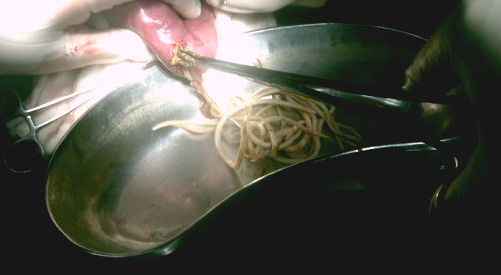Ascariasis surgery: Difference between revisions
Jump to navigation
Jump to search
No edit summary |
No edit summary |
||
| Line 22: | Line 22: | ||
[[File:IMAG0459.JPG|thumb|Worm extraction via enterotomy|center]] | [[File:IMAG0459.JPG|thumb|Worm extraction via enterotomy|center]] | ||
* Intestinal resection and end-to-end anastomosis if necessary | * Intestinal resection and end-to-end anastomosis if necessary | ||
==References== | ==References== | ||
{{Reflist|2}} | {{Reflist|2}} | ||
Revision as of 19:43, 6 March 2017
|
Ascariasis Microchapters |
|
Diagnosis |
|---|
|
Treatment |
|
Case Studies |
|
Ascariasis surgery On the Web |
|
American Roentgen Ray Society Images of Ascariasis surgery |
Editor-In-Chief: C. Michael Gibson, M.S., M.D. [1]Associate Editor(s)-in-Chief: Fatimo Biobaku M.B.B.S [2]
Overview
Surgery
Some of the indications for the surgical management of ascariasis include:[1]
- Complete intestinal obstruction with inadequate decompression
- Lack of response within 24-48 hrs of medical management of obstruction
- Complications such as volvulus, intussusception or intestinal perforation
- Acute appendicitis
- Worms trapped in ducts
- Liver invasion by worms
Surgical therapy
Hepatobiliary ascariasis
The surgical management for hepatobiliary infestation with ascaris include:[2]
- Endoscopic management: This entails endoscopic extraction of the worm
- Laparoscopic management: This often entails laparoscopic cholecystectomy, common bile duct exploration with parasite extraction, and T-tube placement.
Intestinal obstruction due to ascariasis
Intestinal obstruction from ascariasis can be surgically managed via the following methods:[3][1]
- External "milking" of the obstructing bolus of worms from the ileum into the colon
- Enterotomy to manually extract the worms

- Intestinal resection and end-to-end anastomosis if necessary
References
- ↑ 1.0 1.1 Durand, Marlene (2015). "Chapter 288:Intestinal Nematodes (Roundworms)". Mandell, Douglas, and Bennett's Principles and Practice of Infectious Diseases Updated Edition, Eighth Edition. Elsevier. pp. 3199–3207. ISBN 978-1-4557-4801-3.
- ↑ Astudillo JA, Sporn E, Serrano B, Astudillo R (2008). "Ascariasis in the hepatobiliary system: laparoscopic management". J Am Coll Surg. 207 (4): 527–32. doi:10.1016/j.jamcollsurg.2008.05.020. PMID 18926454.
- ↑ Villamizar E, Méndez M, Bonilla E, Varon H, de Onatra S (1996). "Ascaris lumbricoides infestation as a cause of intestinal obstruction in children: experience with 87 cases". J Pediatr Surg. 31 (1): 201–4, discussion 204-5. PMID 8632280.